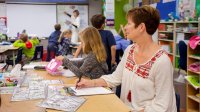A Schoolwide Focus on Improving Students’ Reading Skills
Differentiated instruction was the key when an elementary school sought more equitable outcomes in students’ growth as readers.
Your content has been saved!
Go to My Saved Content.We’re all familiar with data correlating student achievement with family income and ethnicity. Such data, critics argue, reveal that schooling tends to sort students according to the pre-existing socioeconomic class structure and, in so doing, reproduces existing inequities. To counter that at Hopkins Elementary in Littleton, Colorado, our staff was determined to help all students learn and thus achieve more equitable outcomes.
The key to achieving more equitable outcomes is to clearly articulate the learning that matters most and then be relentless in helping all students to get there. We focused on students’ reading achievement as our top priority. We began the year with an assessment of each student’s reading level and set specific individual goals stating what we expected every student to achieve by May. We sought grade level proficiency for every student, and we expected at least one year of growth for every student as well. However, for those performing below grade level, we expected up to one and a half years of growth so that they could narrow, if not eliminate, their learning gap.
Intentionally Unequal
Without this intentional and deliberate commitment to learning, it’s far too easy for educators to slip into the de facto role of ranking students. When this occurs, concerns about fairness often center on preventing cheating and on treating every student equally as teachers work to maintain what they see as a fair competition for the grade commodity.
Guided by teacher leaders and our leadership team, we embraced a different concept of fairness. Grounded in the fundamental beliefs that all kids can learn and that it is our job to make it happen, we understood fairness to mean giving each student what he or she needed.
With this concept of fairness in mind, we created an entire reading period designed to treat kids unequally. Specifically, within our literacy block we eliminated guided reading and replaced it with differentiated reading instruction (DRI). This 40-minute period provided the opportunity for teachers to tailor instruction to address identified skill gaps.
During this block, teachers grouped students according to their assessed needs. These groups, which replaced guided reading groups, were short-term and fluid, shifting as students’ needs shifted. We used a variety of tools to diagnose needs and monitor growth, including the Phonological Awareness Screening Test (PAST), the CORE Phonics Survey, the Words Their Way Spelling Inventory, fluency timed readings, and others.
Teachers chose two areas of instructional focus using Sharon Walpole and Michael McKenna’s cognitive reading model, supporting students as they developed phonemic awareness, word recognition, fluency, improved vocabulary, and reading comprehension skills.
We staggered our DRI block by grade level so our reading interventionists and special education teachers could “push in” to every classroom and work with each teacher to provide additional differentiated instructional support to every student who needed it. This added support created many options for differentiation. There could be two small groups in a given classroom receiving direct instruction. Alternatively, a specialist could co-teach a group, or work one-on-one with individual students.
Every six weeks, we met as a professional learning community to review formative data and plan the next DRI segment of learning. Teachers regrouped their students according to recent data, identifying two updated areas for instructional focus and setting new short-term growth goals.
Most notably, teachers collaborated—sharing with grade level teammates their most successful instructional strategies, seeking support from our literacy coach in cases where growth lagged, and teaming with our special education staff and reading specialists to ensure that extra attention, time, and resources were applied where the need was greatest.
To evaluate the effectiveness of this initiative, our leadership team developed an implementation rubric. This rubric functioned as a tool for classroom observation and enabled us to design ongoing professional development based on these observations and on data detailing student growth.
Measuring What Matters
Finally, an important part of this initiative was our all-staff year-end meeting, during which each teacher presented her or his class data to colleagues. It was both a celebration and a form of accountability—to each other and to our students. This year-end meeting required vulnerability on the part of our teachers as they stood before colleagues, detailing how many students had attained their growth goal and how many students were proficient. But that risk was more than matched by their courage, drawn from their clarity of purpose and from a sense that we were all in the work together.
The percentage of our students who were at grade level as predicted by Measures of Academic Progress (MAP) increased from 69 percent when we began this initiative to 88 percent within three years. In addition, the percentage of students who were growing at least as fast as the state median jumped from only 40 percent at the baseline to 58 percent.
Teachers worked all year knowing that in the end what would be measured, and what truly mattered, was each and every student’s learning. Because if we are to be a gateway to opportunity rather than a gatekeeper of the status quo, giving students what they need is only fair.
I’d like to express my gratitude to Dr. Barbara Trenholme for her contributions to this article.
